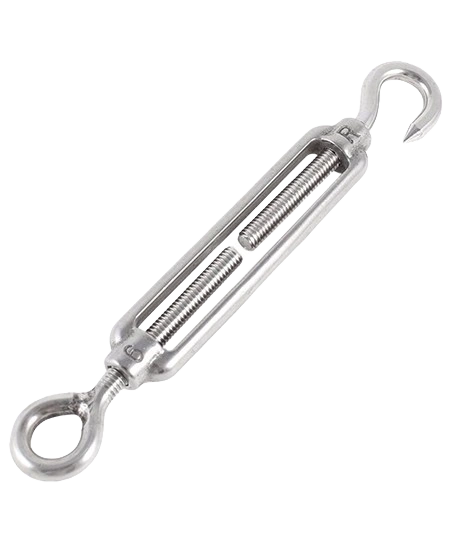DIAGRAM

SPECIFICATIONS
| SIZE | A | B | C | D | E | WLL | WT |
| mm | mm | mm | mm | mm | mm | TONE | KGS |
| 5M | 5 | 70 | 130 | 8 | 9 | 0.1 | 0.038 |
| 6M | 6 | 100 | 160 | 10 | 9 | 0.25 | 0.063 |
| 8M | 8 | 125 | 200 | 12 | 10 | 0.35 | 0.137 |
| 10M | 10 | 150 | 245 | 16 | 11 | 0.5 | 0.247 |
| 12M | 12 | 200 | 300 | 20 | 14 | 1 | 0.459 |
| 16M | 16 | 250 | 400 | 22 | 18 | 1.5 | 1.038 |
| 20M | 20 | 300 | 480 | 28 | 20 | 2.3 | 1.811 |
PRODUCT FEATURES
- Material: AISI304 or AISI316 stainless steel
- Standard: JIS Standard
- Size Range: M5 to M20
- Corrosion Resistant
- Versatile Fitting Types: Hook and Eye
- Precision Tension Adjustment
- Non-lifting Applications: For rigging, suspension, and slack removal
INSTRUCTIONS & CAUTIONS
Use in Appropriate Applications
Hook eye turnbuckles are designed for tensioning and slack removal in rigging, suspension, and support systems. They should never be used for lifting or any applications that involve sudden release of tension. Ensure the turnbuckle is used only for in-line, straight-pull applications where precise tension control is needed.
Check for Proper Threading
Before installation, always verify that the threads are properly aligned. The turnbuckle has left and right-hand threads on opposite ends, which allow for tension adjustment. Misalignment or cross-threading can compromise the strength and performance of the turnbuckle, leading to potential failure under load.
Inspect Regularly for Corrosion
Although these turnbuckles are made from AISI304 or AISI316 stainless steel for enhanced corrosion resistance, it’s important to regularly inspect them for signs of wear or corrosion, especially in harsh environments like marine or industrial settings. Corrosion can weaken the material and affect the turnbuckle’s performance over time.
Avoid Over-tightening
When adjusting the tension, avoid over-tightening the turnbuckle. Excessive tension can stress the body and fittings, potentially leading to failure. Always follow manufacturer recommendations for tension limits, and make sure that all components in the rigging system are compatible to prevent undue strain on the turnbuckle.
OUR ADVANTAGES
Custom-Engineered Solutions
We understand that each project is unique, which is why we offer custom-engineered solutions. Whether you need a specific size, material, or configuration, our team is ready to help. We can tailor our JIS Stainless Steel Hook Eye Turnbuckles to meet your precise requirements, ensuring they fit perfectly into your rigging systems and deliver optimal performance.
Direct from Manufacturer
At Powerful Machinery, we offer JIS Stainless Steel Hook Eye Turnbuckles directly from the manufacturer, ensuring you get top-quality products at the best possible prices. Without middlemen, we can pass savings on to you and maintain full control over the production process. This direct approach guarantees consistent quality, fast production times, and lower costs for you.
Quality & Safety First
We prioritize quality and safety in every step of our production. Our turnbuckles are made from premium AISI304 or AISI316 stainless steel, providing excellent corrosion resistance. Rigorous testing ensures they meet JIS standards for strength and reliability. With Powerful Machinery, you can trust that you’re receiving a safe, high-quality product for your rigging needs, every time.
Efficient Logistics & After-Sales Service
With Powerful Machinery, you benefit from efficient logistics and comprehensive after-sales service. Our streamlined transportation ensures fast and reliable delivery to meet your deadlines. After your purchase, our dedicated support team is always available to assist with any issues, offering technical advice or solutions to keep your operations running smoothly.
OUR REVIEWS



FAQ
What is a turnbuckle?
A turnbuckle is a metal device used to adjust tension or length in rigging and suspension systems. It consists of a central body with two threaded ends—typically a hook, eye, or jaw. The two ends are rotated to either tighten or loosen the turnbuckle, allowing you to apply precise tension. It’s often used in construction, marine, and industrial applications where adjusting slack or tension is needed.
How to use a turnbuckle?
-
Attach the Fittings
Begin by securely attaching the hook-eye or eye-eye fittings to the components you wish to connect. Ensure they are tightly fastened to avoid any movement or slippage. -
Align the Turnbuckle
Before tightening or loosening, check that the turnbuckle is correctly aligned with the rigging system. This ensures smooth operation when adjusting tension. -
Rotate the Central Body
Turn the central body of the turnbuckle by rotating it in either direction. Rotating it will either tighten or loosen the ends of the turnbuckle, depending on your needs. This adjustment will remove slack or increase tension as necessary. -
Ensure Proper Threading
Make sure that both ends of the turnbuckle are not cross-threaded. Improper threading can weaken the connection and compromise safety. Always check that the threads are aligned before beginning the adjustment process. -
Adjust Tension to Desired Level
Continue rotating the turnbuckle until the tension is at the desired level. Be sure to adjust carefully and avoid over-tightening to maintain the safety and integrity of the rigging system.
How does a turnbuckle work?
A turnbuckle works by using threaded ends on a central body to tighten or loosen the assembly. Each end of the turnbuckle has a different type of fitting (hook, eye, etc.), and they rotate in opposite directions. As you turn the central body, one fitting pulls in while the other pushes out, gradually adjusting the tension and length of the rigging system. This is how slack is removed, and precise tension is achieved.
What are turnbuckles used for?
Turnbuckles are primarily used to adjust tension in rigging and suspension systems. They’re found in industries like construction, marine, and industrial sectors, where reliable and adjustable connections are needed. Turnbuckles help secure ropes, cables, or tie rods, ensuring that structures remain stable under tension. They’re also essential in fine-tuning the length of ropes or cables, providing precise control over the setup.
What are the types of turnbuckles?
There are several types of turnbuckles, each designed for different rigging needs. Common types include eye-eye turnbuckles (for secure connections), hook-eye turnbuckles (for quick attachment), and jaw-eye turnbuckles (for heavy-duty applications). Stainless steel turnbuckles, such as those made from AISI304 or AISI316, offer excellent corrosion resistance for marine or outdoor applications. The choice depends on load requirements and environment.
How to tighten a turnbuckle?
-
Rotate the Central Body
To tighten the turnbuckle, rotate the central body in the direction that draws the two fittings closer together. This will apply the desired tension to the rigging. -
Turn Clockwise for Hook-Eye Turnbuckles
For a hook-eye turnbuckle, turn the body clockwise to pull the eye fitting tighter. This increases the tension and removes slack in the system. -
Check Thread Alignment
Before tightening, ensure both threads are securely threaded and aligned. Misaligned threads can lead to improper tensioning and may damage the turnbuckle. -
Use a Wrench for More Torque
If more force is required, use a wrench to apply additional torque. This will help you tighten the turnbuckle effectively. -
Avoid Over-Tightening
Be cautious not to over-tighten. Excessive force can damage the threads or place unnecessary strain on the rigging system, compromising safety and performance.




